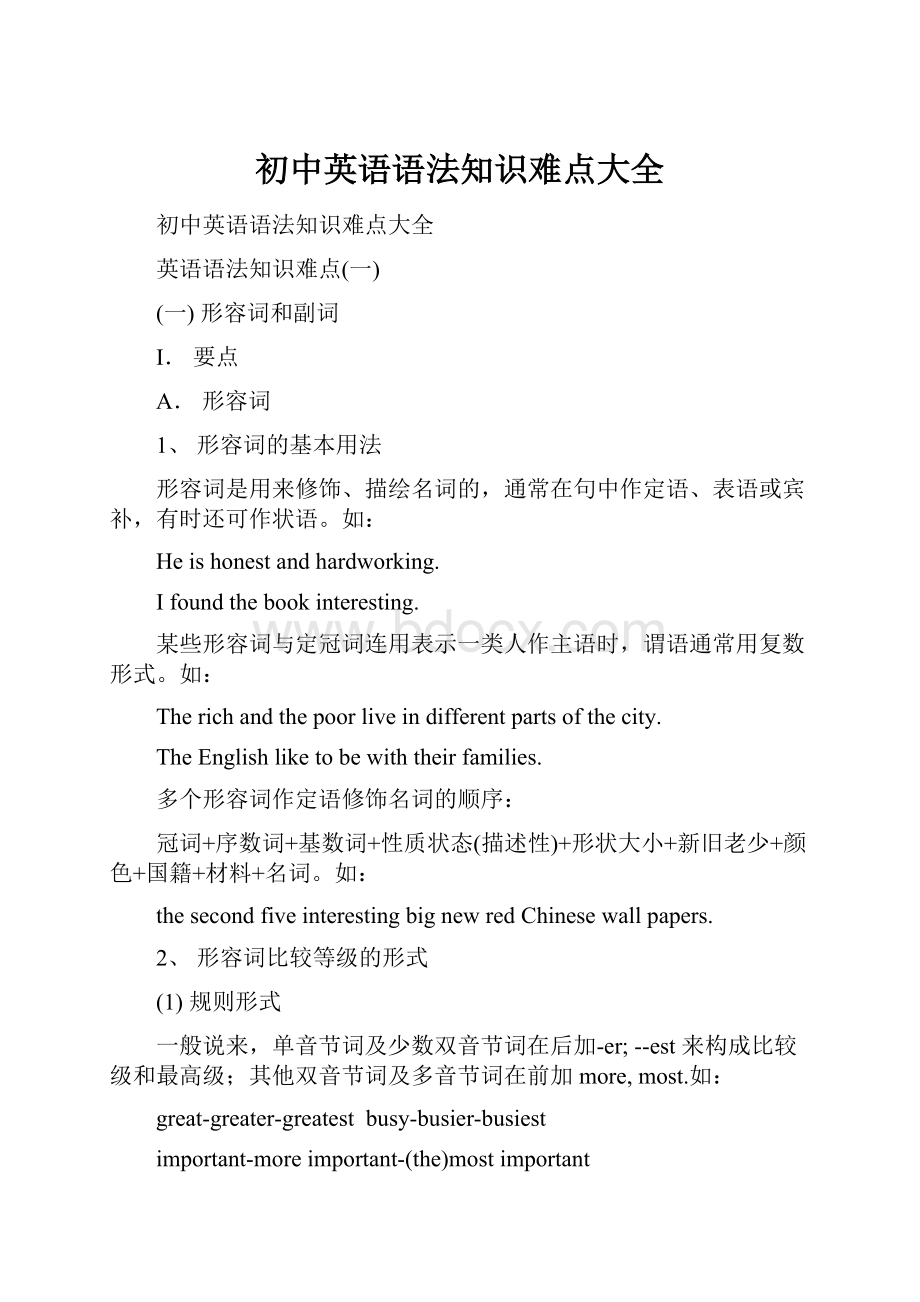初中英语语法知识难点大全.docx
《初中英语语法知识难点大全.docx》由会员分享,可在线阅读,更多相关《初中英语语法知识难点大全.docx(31页珍藏版)》请在冰豆网上搜索。

初中英语语法知识难点大全
初中英语语法知识难点大全
英语语法知识难点
(一)
(一)形容词和副词
I.要点
A.形容词
1、形容词的基本用法
形容词是用来修饰、描绘名词的,通常在句中作定语、表语或宾补,有时还可作状语。
如:
Heishonestandhardworking.
Ifoundthebookinteresting.
某些形容词与定冠词连用表示一类人作主语时,谓语通常用复数形式。
如:
Therichandthepoorliveindifferentpartsofthecity.
TheEnglishliketobewiththeirfamilies.
多个形容词作定语修饰名词的顺序:
冠词+序数词+基数词+性质状态(描述性)+形状大小+新旧老少+颜色+国籍+材料+名词。
如:
thesecondfiveinterestingbignewredChinesewallpapers.
2、形容词比较等级的形式
(1)规则形式
一般说来,单音节词及少数双音节词在后加-er;--est来构成比较级和最高级;其他双音节词及多音节词在前加more,most.如:
great-greater-greatestbusy-busier-busiest
important-moreimportant-(the)mostimportant
(2)不规则形式
good(well)-better-bestbad(ill)-worse-worst
many(much)-more-mostlittle-less-least
(3)形容词比较等级的用法
①表示两者的比较,用形容词的比较级+than.如:
Heisclevererthantheotherboys.
Thisoneismorebeautifulthanthatone.
②表示两者以上的比较,用"the+形容词最高级(+名词)+of(in)…"如:
Heisthecleverestboyinhisclass.
③表示两者是同等程度,用"as+形容词原级+as".如:
HeisastallasI.
Ihaveasmanybooksasyou.
④越…越…
例如:
ThemoreIlearn,thehappierIam.
⑤Youcanneverbetoocareful.越小心越好
又如:
Youcanneverpraisetheteachertoohighly.你怎么赞扬这个老师也不过分。
⑥Ihaveneverspentamoreworryingday.那一天是最令我担心的一天。
Ihaveneverhadabetterdinner.这是我吃过的最好的一顿饭。
⑦MyEnglishisnobetterthanyours.我的英语和你的英语都不怎么样。
B.副词
1、副词的种类
(1)时间副词如:
ago,before,already,just,now,early,late,finally,tomorrow等
(2)地点副词如:
here,there,near,around,in,out,up,down,back,away,outside等。
(3)方式副词如:
carefully,angrily,badly,calmly,loudly,quickly,politely,nervously等。
(4)程度副词如:
almost,nearly,much,greatly,abit,alittle,hardly,so,very等。
2、副词比较等级的用法
其用法与形容词相似,只是副词最高级前可省略定冠词。
如:
Ofalltheboyshesings(the)mostbeautifully.
Wemustworkharder.
3、某些副词在用法上的区别
(1)already,yet,still
already表示某事物已经发生,主要用于肯定句;yet表示期待某事发生,主要用于否定句和疑问句;still表示某事还在进行,主要用于肯定句和疑问句,有时也可用于否定句。
如:
We'vealreadywatchedthatfilm.
Ihaven'tfinishedmyhomeworkyet.
Hestillworksuntillateeverynight.
(2)too,aswell,also,either
too,aswell和also用于肯定句和疑问句,too和aswell多用于口语,一般放在句末,而also多用于书面语,一般放在句中与动词连用。
either用于否定句和否定的疑问句,往往放在句末。
如:
Hewenttheretoo.
Hedidn'tgothereeither.
Ilikeyouaswell.
Ialsowentthere.
(3)hard,hardly
hardly意为"几乎"与hard在词义上完全不同。
如:
Iworkhardeveryday.
Icanhardlyrememberthat.
(4)late,lately
lately意为"最近、近来",late意为"晚、迟"。
如:
Henevercomeslate.
Haveyoubeentothemuseumlately?
II.例题
例1Tom'sfatherthinksheisalready____
AhighenoughBtallenoughCenoughhighCenoughtall
解析:
该题正确答案是B。
修饰人高用tall,而建筑物的高用high,并且enough修饰形容词要放在形容词后面。
因此该题选B。
例2____theworseIseemtobe.
AWhenItakemoremedicineBThemoremedicineItake
CTakingmoreofthemedicineDMoremedicinetaken
解析:
该题正确答案为B。
"the+形容词比较级+…,the+形容词比较级+…"意为越…,越…。
该句意为:
吃的药越多,我的病越是加重。
例3"Ihaven'tbeentoLondonyet".
"Ihaven'tbeenthere____".
AtooBalsoCeitherDneither
解析:
该题正确答案为C。
A和B都用于肯定句中。
D-neither本身意为否定"两者都不",而C-either则用于否定句中,意为"也"。
例4MrSmithwas____movedatthenews.
AdeepBdeeplyCverydeepDquitedeeply
解析:
该题正确答案为B。
A.deep用于副词时,修饰具体的深,如digdeep,而B-deeply则修饰表示感情色彩的词,如该题为deeplymoved.另如deeplyregret等。
而D-quite和deeply均为副词,不能互相修饰。
(二)介词
I.要点
1、介词和种类
(1)简单介词,常用的有at,in,on,about,across,before,beside,for,to,without等。
(2)复合介词,如bymeansof,alongwith,becauseof,infrontof,insteadof等。
2、介词和其他词类的习惯搭配关系
(1)和动词的搭配,如agreewith,askfor,belongto,breakawayfrom,careabout等。
(2)和形容词的搭配,如afraidof,angrywith,differentfrom,goodat
(3)和名词的搭配,如answerto,keyto,reasonfor,causeof,visitto等.
3、介词短语可以有自己的修饰语,这种修饰语通常有right,just,badly,all,well,directly,completely等少数几个副词。
如:
Hecamerightafterdinner.
Helivesdirectlyoppositetheschool.
4、某些介词的意义与用法举例
(1)at,on,in
表时间
表示时间点,某一时刻/年龄用at,如atfouro'clock,atmidnight,attheageof等;表示不确定的时间或短期假日也用at,如atthattime,atChristmas等。
指某天用on,on表示星期几/某一具体的日子/具体某天的上午/下午/晚上,表示一天中的三个时间段名词前有修饰语或后有修饰语时如onMonday,ontheendofNovember等。
in表示时间段,一天的三个时间段以及月份,年,季节,世纪,人生的某个时期(某人几十岁时) inthemorning/afternoon/evening,inspring/in2007/inMarch,inthetwenty-firstcentury,inhisfifties。
表地点:
1)at一般指较小的地点或较具体的位置
atthestationatthecinema
2)in表示在较大的地点或一个有限空间里.
inChinaintheclassroom
3)on指在某物体的表面上.
onthedesk
注意:
写街道时,若有门牌号用at,否则用on/in都可.
Helivesat270DongChang’anStreet.
(2)between,among(表位置)
between仅用于二者之间,但说三者或三者以上中的每两个之间的相互关系时,也用between,如
I'msittingbetweenTomandAlice.
Thevillageliesbetweenthreehills.
among用于三者或三者以上之间。
如:
Heisthebestamongthestudents.
(3)beside,besides
beside意为"在…旁边",而besides意为"除…之外"。
如:
Hesatbesideme.
Whatdoyouwantbesidesthis?
(4)inthetree,onthetree
onthetree表示“树上本身长的东西”在树上.而inthetree表示“外界的物体进入树中”人或物在树上.
Therearesomeapples_____thetree.
Thereisaboy____thetree
(5)ontheway,intheway,bytheway,inthisway
ontheway指在路上intheway指挡道bytheway指顺便问一句inthisway用这样的方法
(6)inthecorner,atthecorner
inthecorner指在拐角内atthecorner指在拐角外
(7)inthemorning,onthemorning
inthemorning是一般说法onthemorning特指某一天的早晨
(8)bybus,onthebus
bybus是一般说法onthebus特指乘某一辆车
(9)介词in/on/to表方位:
in表示A地在B地范围之内.(包含关系)
Tanwanis____thesoutheastofChina.
on表示A,B地接壤.(外切关系)
Hubeiis____thenorthofHunan.
to表示A,B两地有一定的间距.(外离关系)
Japanis_____theeastofChina.
(10)after/in在……之后
after
1)after+时间段.表示以过去某一时刻为起点的一段时间之后,用于过去时.
2)after作介词.afterdoingsth
in+一段时间.表示说话时或以现在为起点的将来一段时间之后.用于将来时.
Hecameback______twodays.
Hewillgohome___finishinghishomework.
Hewillcomeback_____twodays.
(11)with/in/by表示“用……”
with表示“用…”一般指有形的工具/手段/人体器官.
Hecuttheappleintohalves____aknife.
注:
with表伴随,“带有,含有”
Hecamein_____abigsmileonhisface.
in表示用某种语言,方式,途径.或书写/绘画所用的材料.也可表交通方式.
Canyousayit_____English?
Hewrotealetter____blueink.
by表示乘坐交通工具,表示方式,方法
Istudyforatest_____workingwithagroup.
Hemakesaliving____sellingnewspapers.
注意:
同义词组
1).byphone=onthephone
2).bycar=inacar
3).inpen=withapen=withpens
(12)across/through/over/by经过
across指横穿,穿过.表示动作从某一物体表面上经过.
through指穿过,透过,表示从某一物体空间内通过.
over表示从某人或某物的上空经过或越过,不与表面接触.
by表示从某人/某物的旁边经过.
Canyouswim______theriver?
Theelephantissobigthatitcan’tgo_____thegate.
Idon’tthinkanyonecanjump___thefence.
Iwalked_____thebankofChinayesterday.
(13)infrontof/inthefrontof
inthefrontof表示在…….内部的前面
infrontof表示在……外面的前面
Thereisadeskin_____frontofourclassroom.
Thereisabigtreein_____frontofourclassroom.
(14).其它介词的用法:
1.at的其它用法.
1).表示“从事或正在做某事”,其后加的名词往往不加冠词.
Sheisatworknow=Sheisworkingnow.
2)at表示“价格或速度”
Thetrainranat120kilometresanhour.
2.in的其它用法:
1)in表示“在……方面”
词组:
dowellin=begoodat
beweakin
2)in表示“穿着”后接表颜色的词或衣服.
词组:
bein+衣服=bewearing+衣服
3)in作副词,“在家”=athome
3.like的用法:
1).像/和……一样.常与系动词连用.
词组:
looklikesoundlike
2).与what连用,“是什么样子,怎样”.
Whatishelike?
Heiskind.
4.off的用法:
1).从……下来,脱离某物体.
词组:
falloff
2).“休假”通常放在时间名词之后.
词组:
have+时间+off
Hehasn’thadanightofffortwohours.
5.except/besides
1).except除了…….之外,都……..不包括在范围之内.
注:
nothingbut…除了……之外,什么也没有.
2).besdies除了……之外,还有…….包括在范围之内.
Weallwentswimming______Lucy.
Thereis_______aletterinthebox.
WestudyJapaneseandFrench____English.
6.with/without
1).with具有,含有-----反义词:
without没有
词组:
withthehelpof=withone’shelp=becauseof=thanksto
withoutone’shelp
2).without的用法:
A).without+sb./sth.没有某人或某物
B).without+doingsth.
Heleftherewithout____(say)“Goodbye”tous
C).withoutsth常与if引导的否定的条件句.
Ifthereisnowater,wecan’tlive.=Wecan’tlive_____________.
7.since/for
注:
since/for用于现在完成时.
1).since:
a).since+时间点
b).现在完成时+since+一般过去时
c).since+一段时间+ago.
2)for:
for+一段时间=since+一段时间+ago
8.bemade+介词的区别:
bemadeof由…制成(看得见原材料)
bemadefrom由…制成(看不见原材料)
bemadein+地点由哪儿生产
bemadebysb.由某人制造
9.表示“数量的介词”
about,roundaroundover
1).about,roundaround表示“大约……”
2).over表示“超过”=morethan.
10.inside/outside
Inside在……里面------反义词:
outside在….外面
11.inthewall/onthewall
inthewall表示“门窗在墙上”onthewall表示“某东西张贴或挂在墙上”
12.不用介词的情况:
1).当时间状为:
tonight,today,yesterday,tomorrow等时,不用介词.
Whatareyougoingtodotonight?
2).含有this,that,these,those,last,next,every,each等时间状语.
HewenttoWuhanlastweek.
3).以all开头的时间状语前面不用介词.
Hehasworkedallday.
4).以some,any,one等构成的时间状语前不用介词
II.例题
例1Doyouknowanyotherforeignlanguage____English?
AexceptBbutCbesideDbesides
解析:
A、B两项except等于but,意为"除了…",C-beside意为"在…旁边",不符合题意。
而D-besides,意为"除了…之外,还有"。
所以该题正确答案为D。
该题意为:
除了英语外,你还知道别的语言吗?
例2Hesuddenlyreturned____arainynight.
AonBatCinDduring
解析:
我们均知道,atnight这一短语,但如果night前有修饰词,表具体的夜晚,则要用介词on来修饰,故该题正确答案为A。
例3I'mlookingforward____yourletter.
AtoBinCatDon
解析:
该题正确答案为A。
lookforwardto为固定搭配,意为"期望、盼望"。
(三)连词
I.要点
1、连词的种类
(1)并列连词用来连接并列关系的词、短语或分句,如and,for,or,both…and,either…or,neither…nor等。
(2)从属连词用来引导从句,如that,if,whether,when,after,assoonas等。
除了从属连词(引导状语从句)外,还有其它可以用来引导从句的词类。
它们是连接代词和连接副词(引导名词性从句),关系代词和关系副词(引导定语从句)。
2、常用连词举例
(1)and和,并且
Theydrankandsangallnight.
(2)both…and和,既…也…
BothmyparentsandIwentthere.
(3)but但是,而
I'msad,butheishappy.
(4)either…or或…或…,要么…要么…
Eitheryou'rewrong,orIam.
(5)for因为
Iaskedhimtostay,forIhadsomethingtotellhim.
(6)however然而,可是
Atfirst,hedidn'twanttogothere.Later,however,hedecidedtogo.
(7)neithe